Nagoya
Anika, where are we?
 On arrival in Nagoya
On arrival in Nagoya
We flew into Nagoya just in time for
our tour of a Toyota factory.
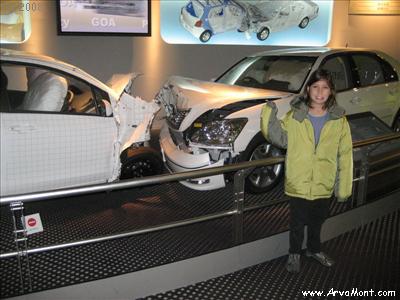 First we wandered around the museum for a while.
First we wandered around the museum for a while.
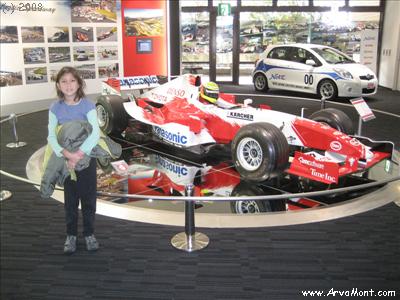
 Wouldn't
this be a cool way to get around? Wouldn't
this be a cool way to get around?
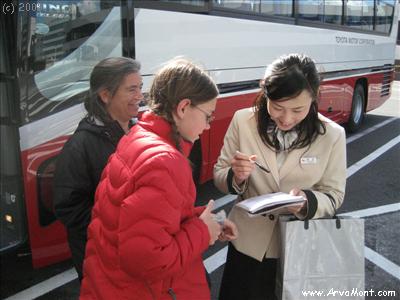 Unfortunately, no photography was allowed at the factory. (Not even of the
bus!)
Unfortunately, no photography was allowed at the factory. (Not even of the
bus!)
The kids loved watching the welding
robots. There were 8 stations, so 8 cars were being welded at once,
with each station focusing on welding a different part. I was impressed
that 4 different models could be made on the same assembly line simultaneously!
All the cars were made to order! And at
the end of the line to see a left steering car rolling off the line among the
right steering ones was just amazing!
Kyoto
We had talked about spending a day in Tokyo on our way out of the country, but
decided we liked Kyoto so much that we'd just skip Tokyo on this trip.
There really is a lot to do in Kyoto, it is an attractive city, and very
manageable in size.
Arashiyama
Sitting in our hotel dining area on our
first evening in Kyoto we were captivated by a poster of a bamboo forest
in Arashiyama, so we made this small town our first stop!
The Bamboo Forest
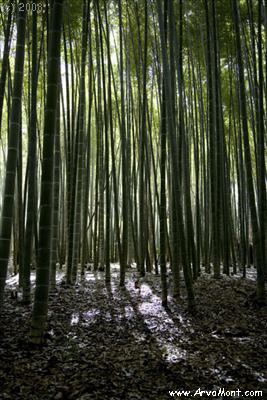
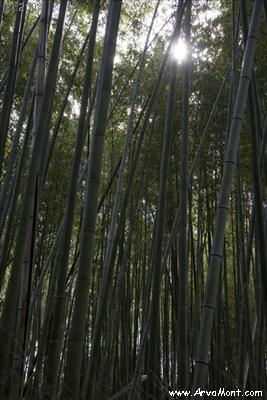

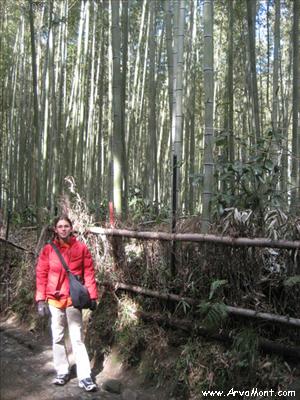
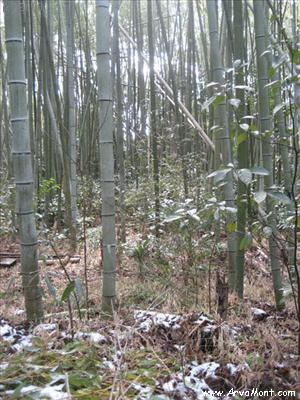
Tenryuji Temple,
As we wandered through the bamboo forest, we encountered this temple, surrounded
by a lovely garden, so we went in to explore.



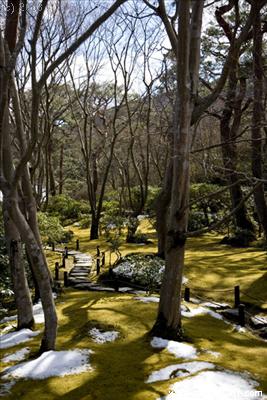
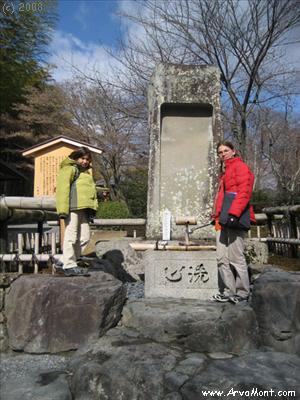

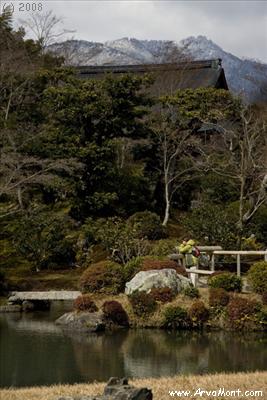
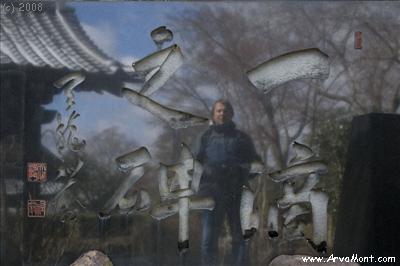 Isn't that an artistic self-portrait?
Isn't that an artistic self-portrait?
Okochi Sanso
and the Jubutsu-do Shrine
A little farther on through the bamboo forest, we found yet another garden!
This one was built by the famous Japanese martial arts actor
Okochi Denjiro. It is nestled into the side of a hill, with a view
overlooking Kyoto, if you just keep climbing. There are little tea houses
and other structures spread throughout.



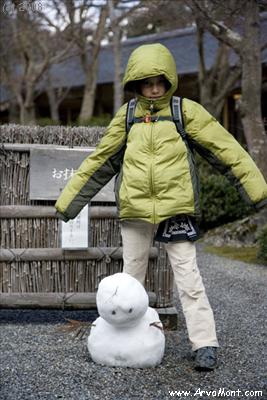

The price of admission included tea, so after we walked about for an hour we
came to the tea house and were served matcha and a sweet. I had read in
the guidebook that the tea cup must be held just so and the tea drunk in 3
gulps. So this is what I did. Then I ate my sweet. Hum, not
exactly my favorite, but alright. Then I started to be embarrassed that
Anika would not so much as try her tea. (Of course she wouldn't, she only
drinks water and sometimes hot chocolate!) So I drank hers too.
Well. This was a mistake. In small doses I could handle the matcha,
but the double portion left me feeling decidedly unwell!

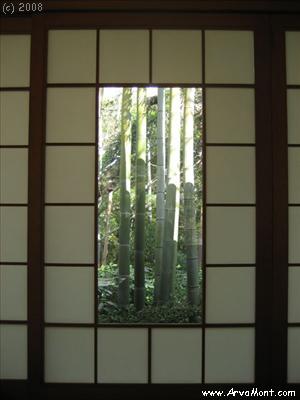
In Arashiyama
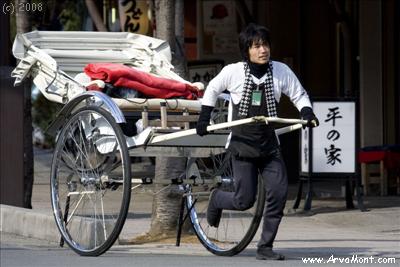

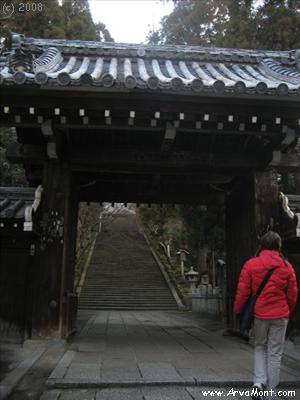
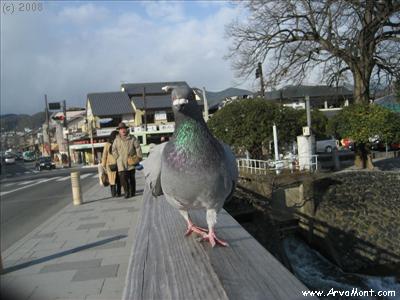
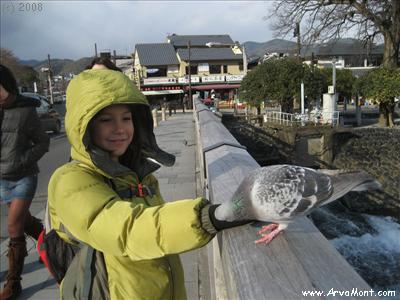
The Fushimi Inari-Taisha
Fushimi Inari Taisha is a Shinto shrine dedicated to
Inari, the god of rice, sake, and prosperity located in Fushimi.
There are many Inari shrines, as Inari is an important god, who now
governs success and prosperity in business. This shrine, which is
one of the oldest in Kyoto, was originally founded in 711 CE. It
is the lead Inari shrine and has responsibility for all 40,000 such
shrines across Japan.
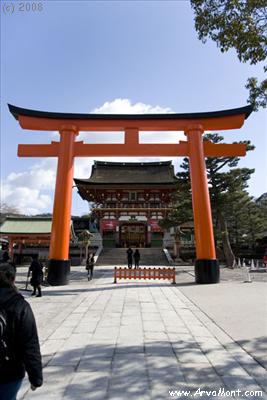
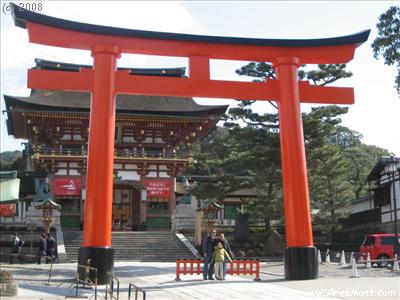
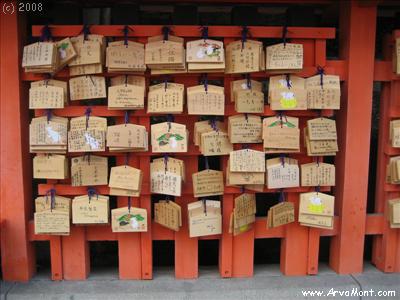
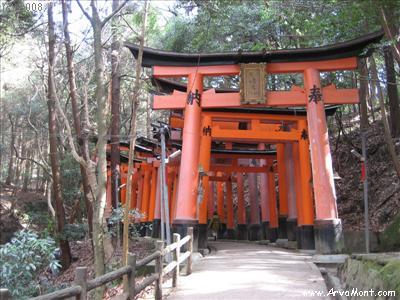
^ If you have a wish, say you would like to do well on your
exams, then you should write this wish on a little wooden board and hang it on
one of many pegs within the shrine. You can also buy a wish at the gift
shop. If you want it to come true, you tie it onto a bush or string within
the shrine. Alternatively, if you don't want it to come true, you tie it
to one of the bushes or the strings within the shrine. (Yeah, I'm confused
by that one too.)
The most remarkable thing, in our
humble opinion, is that the Fushimi Inari shrine has some
10,000 orange torii over the long paths behind
the actual shrine, leading up a hill and to several smaller shrines. These
are all donated by businesses and individuals thankful for the prosperity Inari
has brought them.
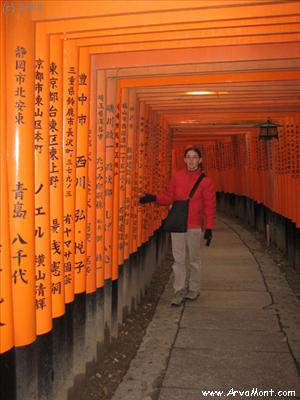


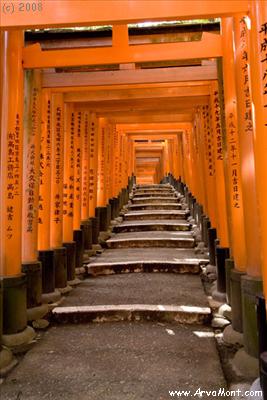
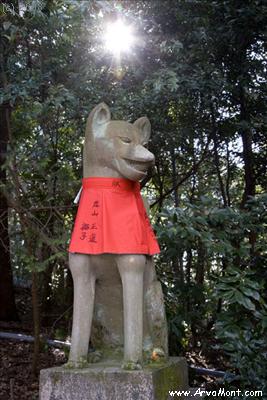
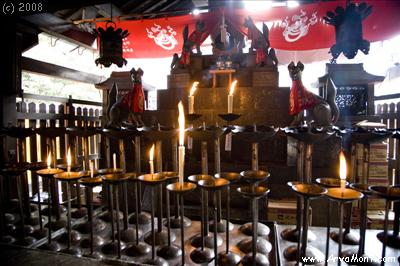
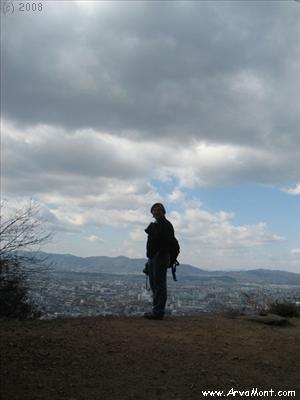
All along the path there were smaller
shrines and memorials, usually also covered in miniature torii. The view
of Kyoto from the top was lovely. Finally we had enough with the
artificial feeling of walking through tunnels in the woods, and struck out on a torii-less path to
head back down into town.

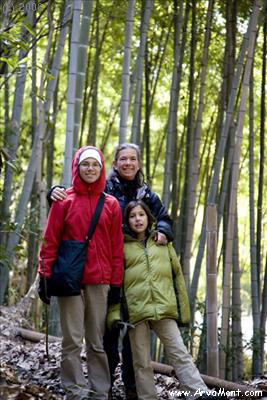

 In Japan,
you're
never more than a few steps from hot and cold drinks...the vending
machines are everywhere. In Japan,
you're
never more than a few steps from hot and cold drinks...the vending
machines are everywhere.
The Nijo Castle
This is the castle used by the Shogun
when he came to Kyoto to visit the emperor. It is austere!
There are a series of rooms defined by tatami walls, which contain magnificent
paintings, but there is really not much in the way of furniture or fixtures.
And the overall size of the castle is quite small.
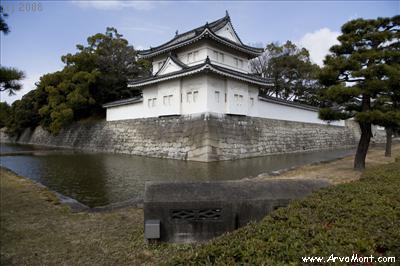 A gate.
A gate.
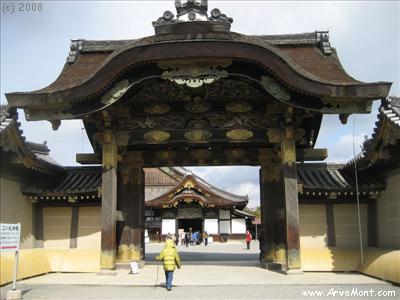 The entrance.
The entrance.

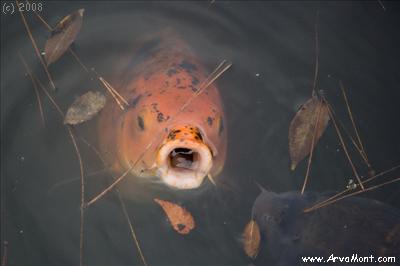 "feed me"
"feed me"
As always, the gardens are my favorite
part!
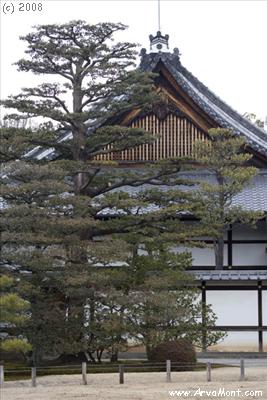

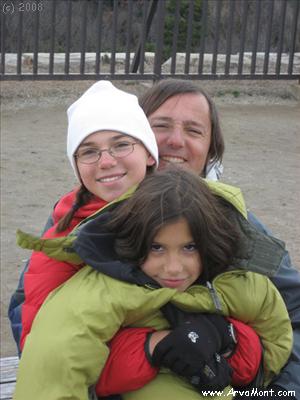

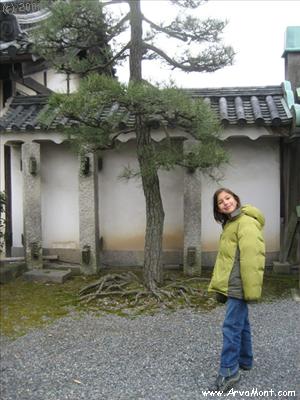
In Our Neighborhood


Made of gum wrappers!
The gas station next door. Look, the pumps are mounted on the ceiling to
save space!
 Even the manhole covers are a work of art!
Even the manhole covers are a work of art!
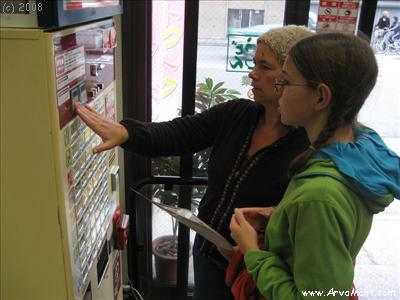
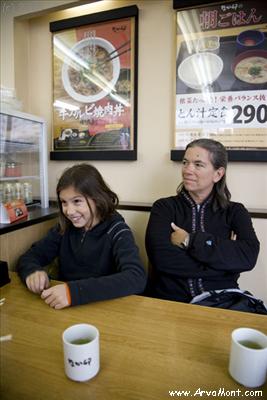
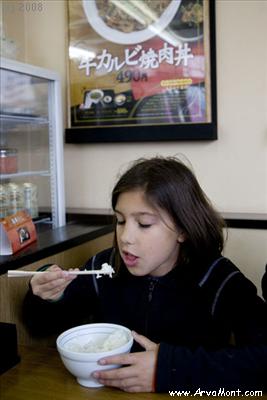
Fast food in Japan doesn't have the
same connotations as in the US. In Japan, it simply means fast food,
reasonably priced. So, we had to try it. Here we are eating at one of the
many automat restaurants we encountered. You order and pay at the automat, turn in your receipt and then the
wait staff bring you your
food!
 This sweet
making machine had us all enthralled for a long time and so we had to buy one of
the sweets it made! We saw the machine drop what we thought was a piece of chocolate in, but
it turned out to be sweet bean paste, so while the resulting pastry was tasty,
it was a little bit of a disappointment given what we thought we were getting. This sweet
making machine had us all enthralled for a long time and so we had to buy one of
the sweets it made! We saw the machine drop what we thought was a piece of chocolate in, but
it turned out to be sweet bean paste, so while the resulting pastry was tasty,
it was a little bit of a disappointment given what we thought we were getting.
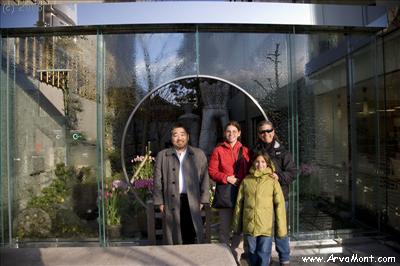

This is the garden down the street
from our hotel, next door to the Lawson's. We met the owner, and he invited us
in to hear the lovely fountain. He has a long bamboo pole mounted into a
pool which is fed by a
small fountain so that you can listen to it. There is a very sweet plink
plink plink to be heard when the water drips from the fountain into the pool.
It is difficult to tell from the photos, but there is water running down the
inside of the glass wall with the circle cut out of it, and the garden has tall
buildings on either side of it!
Nara
This was the first real snow we'd
encountered this winter and the kids had a blast (they've been jealous of their
friends back home having so much snow; Yannis and I have not really
missed it). Between playing with the snow and feeding the
tame deer, we almost didn't have enough time for the sights of Nara.
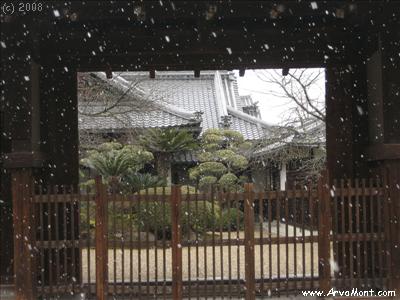
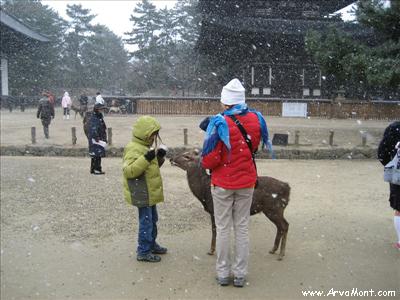
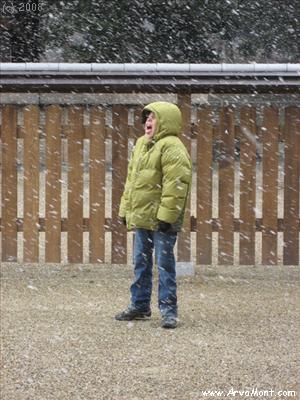
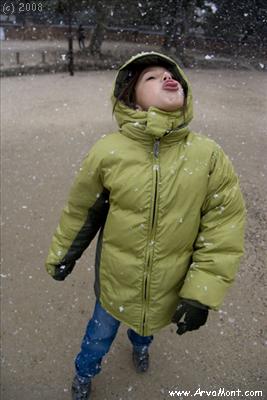
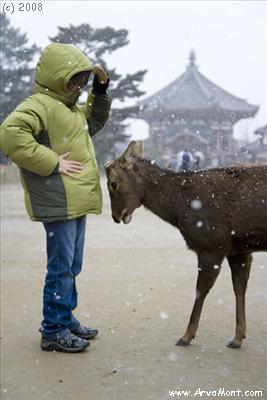
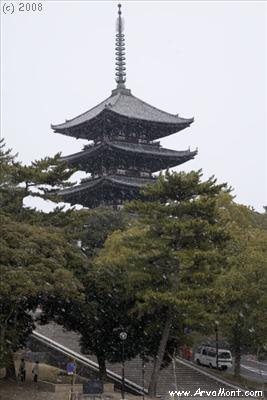
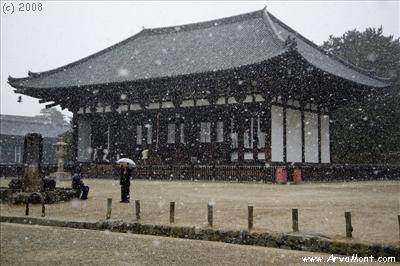

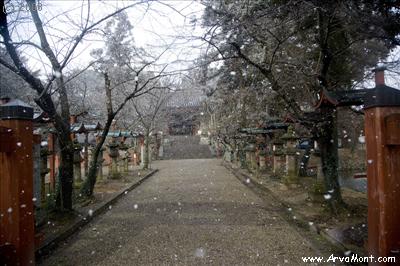
Okumura Memorial Museum
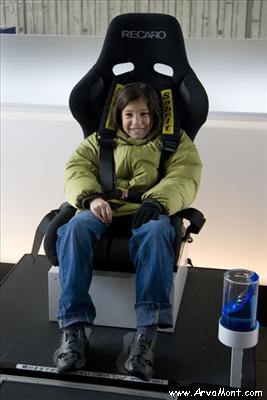
On the walk up to the most famous temple in Nara, we encountered this museum.
It tells the history of the Okumura Corporation. From their lovely
brochure: "...the Company has been steadily developing as a harmonious
general contractor..." Isn't that lovely? "The inside is open to the
public for free admission with a resting space for people to relax in and an
exhibition space to introduce our century of company history. We would be
delighted if many visitors could use this place as a resting house while
strolling around the historic city."
This is a device they use to simulate an earthquake. See the
blue liquid as Anika is experiencing a level 7 earthquake. Then they
switched the chair to the latest earthquake-proof building platform and simulated
the same level 7 earthquake, and guess what? The liquid remained
almost completely steady!
Todaiji Temple
This temple was originally
constructed in 752 CE as the chief Buddhist temple in Japan, and it had so much
influence that the capital of Japan moved from Nara to Nagaoka in order to
escape its undue influence! This temple is the largest wooden structure in the
world, even though when it was rebuilt after a fire in 1692 it was built only
two thirds its original size!
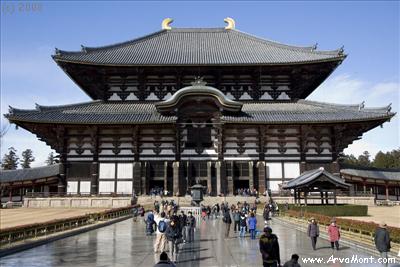 
This Buddha is huge!
See the man lighting a candle in the foreground?

Some inspired monk drilled a hole the size of the Buddha's nostril through
one of the columns behind the Buddha. People now delight in squeezing
through this simulated nostril. It is said to bring good fortune!
Traveling Around Japan
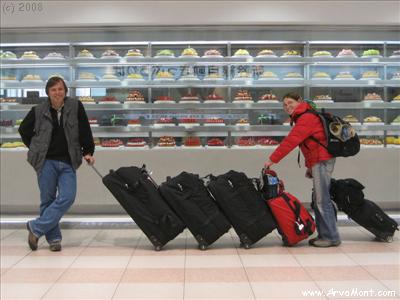 |
We decided it would be fun to create a "suitcase train" for getting
around the Kyoto station. It actually worked quite well, and demonstrated
that we could have brought much more luggage or can simply have
Yannis carry it all from now on! :-)
We also got many funny
looks from the people in the station. |
 |
The Shinkansen Trains (aka "Bullet Trains")
These run frequently between the major
cities and are a great way to get around Japan (albeit a little expensive if you
don't have a JR Rail Pass which has to be purchased before entering Japan -
oops). It takes 2.5 hours to go from Kyoto to Tokyo (averaging about 120
mph), and we basically walked in to the station and bought tickets for the next
train that suited our fancy. We (here you should definitely read Yannis) chose to wait 40 minutes so we could ride one of
the new Series 700 Shinkansen trains. Far faster than flying when you
factor in the 1 hour to get to the airport, 1-1.5 hours before check-in, 1 hour
on the plane, another hour to get from Narita, etc.
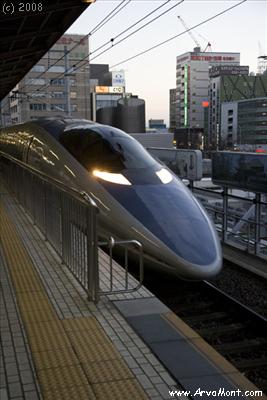

500 Series - still the fastest.
New 700 Series - just a hair slower than the 500, but apparently much more cost
effective to operate.

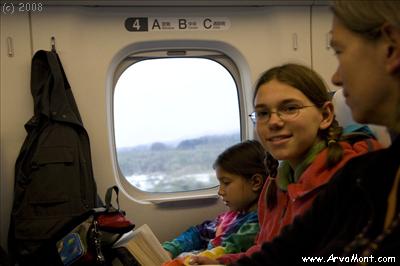
Mt. Fuji from the Shinkansen
Riding in the Shinkansen.
And last, but not least, one of our favorite
images from Japan - these appear to be in almost all the hotels from budget to
high-end:
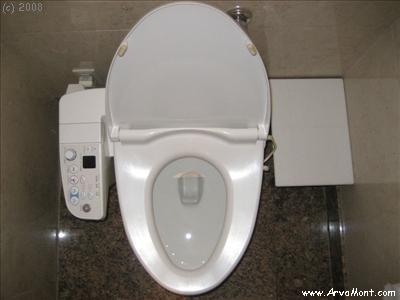
The things you can do with this
toilet! (Unfortunately, doing laundry wasn't one of them!)
The seat is heated, for your comfort -
temperature controls included
(Don't ask us what this feels like!)
There is a bidet option, which we
found mostly scary.
When you sit down, the water starts
running into the bowl automatically.
And then there are still five or six
buttons and dials whose functions we could not ascertain.
From Japan, we headed off to
Guilin, China |  Around
the World With the ArvaMonts
Around
the World With the ArvaMonts

















































































